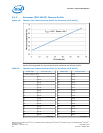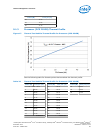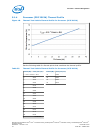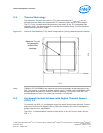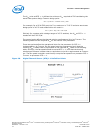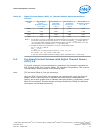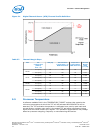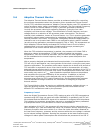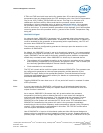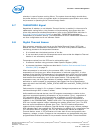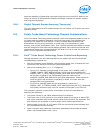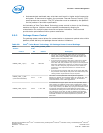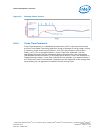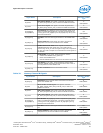
after 1 ms the processor is still too hot (the temperature has not dropped below the
TCC activation point, DTS still = 0 and PROCHOT is still active), then a second
frequency and voltage transition will take place. This sequence of temperature
checking and frequency and voltage reduction will continue until either the minimum
frequency has been reached or the processor temperature has dropped below the TCC
activation point.
If the processor temperature remains above the TCC activation point even after the
minimum frequency has been reached, then clock modulation (described below) at
that minimum frequency will be initiated.
There is no end user software or hardware mechanism to initiate this automated TCC
activation behavior.
A small amount of hysteresis has been included to prevent rapid active/inactive
transitions of the TCC when the processor temperature is near the TCC activation
temperature. Once the temperature has dropped below the trip temperature and the
hysteresis timer has expired, the operating frequency and voltage transition back to
the normal system operating point using the intermediate VID/frequency points.
Transition of the VID code will occur first, to insure proper operation as the frequency
is increased.
Clock Modulation
Clock modulation is a second method of thermal control available to the processor.
Clock modulation is performed by rapidly turning the clocks off and on at a duty cycle
that should reduce power dissipation by about 50% (typically a 30–50% duty cycle).
Clocks often will not be off for more than 32 microseconds when the TCC is active.
Cycle times are independent of processor frequency. The duty cycle for the TCC, when
activated by the Thermal Monitor, is factory configured and cannot be modified.
It is possible for software to initiate clock modulation with configurable duty cycles.
A small amount of hysteresis has been included to prevent rapid active/inactive
transitions of the TCC when the processor temperature is near its maximum operating
temperature. Once the temperature has dropped below the maximum operating
temperature and the hysteresis timer has expired, the TCC goes inactive and clock
modulation ceases.
Immediate Transition to Combined TM1 and TM2
When the TCC is activated, the processor will sequentially step down the ratio
multipliers and VIDs in an attempt to reduce the silicon temperature. If the
temperature continues to increase and exceeds the TCC activation temperature by
approximately 5 °C before the lowest ratio/VID combination has been reached, the
processor will immediately transition to the combined TM1/TM2 condition. The
processor remains in this state until the temperature has dropped below the TCC
activation point. Once below the TCC activation temperature, TM1 will be discontinued
and TM2 will be exited by stepping up to the appropriate ratio/VID state.
Critical Temperature Flag
If TM2 is unable to reduce the processor temperature, then TM1 will be also be
activated. TM1 and TM2 will then work together to reduce power dissipation and
temperature. It is expected that only a catastrophic thermal solution failure would
create a situation where both TM1 and TM2 are active.
Processor—Thermal Management
Desktop 4th Generation Intel
®
Core
™
Processor Family, Desktop Intel
®
Pentium
®
Processor Family, and Desktop Intel
®
Celeron
®
Processor Family
Datasheet – Volume 1 of 2 December 2013
76 Order No.: 328897-004



